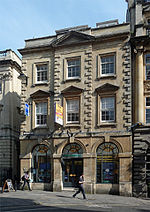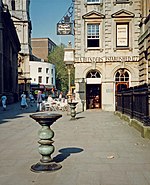Marsh Street
Streets in Bristol

Marsh Street is a street in the city of Bristol, England. Located in the historic city centre of Bristol, it runs in a northerly direction for about 200 yards from its junction with King Street and Prince Street to Clare Street. The street is noted in the diary of Samuel Pepys as the birthplace of his maid and love interest Deb Willet.In 1967, the Bristol and West building society built its then headquarters in Marsh Street. The building has since been converted to different use.
Excerpt from the Wikipedia article Marsh Street (License: CC BY-SA 3.0, Authors, Images).Marsh Street
Marsh Street, Bristol City Centre
Geographical coordinates (GPS) Address Nearby Places Show on map
Geographical coordinates (GPS)
| Latitude | Longitude |
|---|---|
| N 51.452808333333 ° | E -2.5961861111111 ° |
Address
Marsh Street
Marsh Street
BS1 4AX Bristol, City Centre
England, United Kingdom
Open on Google Maps










